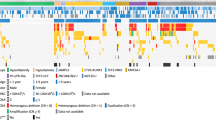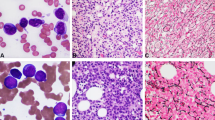Abstract
A higher frequency of acute promyelocytic leukemia (APL) has been noted in countries of Southern Europe and among ‘Latino’ patients of the United States with acute myeloid leukemia (AML). In order to discover whether there is any genetic predisposition to the disease, we analyzed microsatellites flanking PML and RARα genes in 29 t(15;17) APL patients from North Portugal and compared them with a control group of 123 healthy individuals. Fluorescent PCR products were analyzed using an automated capillary electrophoresis system and allele and haplotype frequencies of the two populations were determined. No significant differences were found, suggesting the same genetic origin of patients and healthy individuals. As suggested by the four microsatellites screened, MSI (microsatellite instability) does not explain the increased incidence of t(15;17) APL in this Portuguese population. These results intend to be a new approach to the study of APL, reflecting the particularity of the disease.
This is a preview of subscription content, access via your institution
Access options
Subscribe to this journal
Receive 12 print issues and online access
$259.00 per year
only $21.58 per issue
Buy this article
- Purchase on Springer Link
- Instant access to full article PDF
Prices may be subject to local taxes which are calculated during checkout


Similar content being viewed by others
References
Mitelman F . Catalog of Chromosome Aberrations in Cancer Liss: New York, NY 1988
de The H, Chomienne C, Lanotte M, Degos L, Dejean A . The t(15 ;17) translocation of acute promyelocytic leukemia fuses the retinoic acid receptor alpha gene to a novel transcribed locus Nature 1990 347: 558–561
Grimwade D, Gorman P, Duprez E, Howe K, Langabeer S, Oliver F, Walker H, Culligan D, Waters J, Pomfret M, Goldstone A, Burnett A, Freemont P, Sheer D, Solomon E . Characterization of cryptic rearrangements and variant translocations in acute promyelocytic leukemia Blood 1997 90: 4876–4885
Chillon MC, Gonzalez M, Garcia-Sanz R, Balanzategui A, Gonzalez D, Lopez-Perez R, Mateos MV, Alaejos I, Rayon C, Arbeteta J, Hernandez JM, Orfao A, San Miguel J . Two new 3′ PML breakpoints in t(15;17)(q22;q21)-positive acute promyelocytic leukemia Genes Chromosomes Cancer 2000 27: 35–43
Büchner T, Urbanitz D, Hiddemann, Ruhl H, Ludwig WD, Fischer J, Aul HC, Vaupel HÁ, Kuse R, Zeile G, Nowrousion MR, Konig HJ, Walter M, Wendt FC, Sodomann H, Hossfeld DK, von Paleske A, Loffier H, Gassmann W, Hellrieger KP, Fulle HH, Lunscken C, Emmerich B, Pralle H, Pees HW, Pfreundschuh M, Bartels H, Koeppen KM, Schwerdtfeger R, Donhuiisen-Ant R, Mainzer K, Bonfert B, Koppler H, Zurborn KH, Ranft K, Thiel E, Heinecke A . Intensified induction and consolidation with or without maintenance chemotherapy for acute myeloid leukemia (AML): Two multicenter studies of the German AML Cooperative Group J Clin Oncol 1985 3: 1583–1589
Cassileth PA, Lynch E, Hides JD, Oken MM, Mazza JJ, Bennett JM, McGlave PB, Edelstein M, Harrington DP, O'Connell MJ . Varying intensity of postremission therapy in acute myeloid leukemia Blood 1992 79: 1924–1930
Mayer RJ, Davis RB, Schiffer CA, Berg DT, Powell BL, Schulman P, Omura GA, Moore JO, McIntyre OR, Frei E . Intensive postremission chemotherapy in adults with acute myeloid leukemia. Cancer and Leukemia Group B N Engl J Med 1994 331: 896–903
Head D, Kopecky KJ, Weick J, Files JC, Ryan D, Foucar K, Montiel M, Bickers J, Fishleder A, Miller M, Spier C, Hanson C, Bitter M, Braziel R, Mills G, Welborn J, Williams W, Hewlett J, Willman C, Appelbaum F . Effect of aggressive daunomycin therapy on survival in acute promyelocytic leukemia Blood 1995 86: 1717–1728
Douer D, Preston-Martin S, Chang E, Nichols PW, Watkins KJ, Levine A . High frequency of acute promyelocytic leukemia among Latinos with acute myeloid leukemia Blood 1996 87: 308–313
Fenaux P, Preudhomme C, Lai JL, Morel P, Beuscart R, Bauters F . Cytogenetics and their prognostic value in de novo acute myeloid leukaemia: a report on 283 cases Br J Haematol 1989 73: 61–67
Neves H, Ramos C, da Silva MG, Parreira A, Parreira L . The nuclear topography of ABL, BCR, PML and RARalpha genes: evidence for gene proximity in specific phases of the cell cycle and stages of hematopoietic differentiation Blood 1999 93: 1197–1207
Singer-Sam J, Tanguay RL, Riggs AD . Use of chelex to improve the PCR signal from a small number of cells Amplifications: A Forum for PCR Users 1989 3: 11
Schneider S, Kueffer J, Roessli D, Excoffier L . Arlequin ver. 1.1: a Software for Population Genetic Data Analysis Genetics and Biometry Laboratory: Switzerland 1997
Raymond M, Rousset F . Genepop (version 1.2): population genetics for exact tests and ecumenicism J Hered 1995 86: 248–249
Richards RI, Sutherland GR . Repeat offenders: simple repeat sequences and complex genetic problems Hum Mutat 1996 8: 1–7
Rimsza LM, Kopecky KJ, Ruschulte J, Chen IM, Slovak ML, Karanes C, Godwin J, List A, Willman CL . Microsatellite instability is not a defining genetic feature of acute myeloid leukemogenesis in adults: results of a retrospective study of 132 patients and review of the literature Leukemia 2000 14: 1044–1051
Chen S, Zelent A, Tong J, Yu HQ, Wang ZY, Derre J, Berger R, Waxman S, Chen Z . Rearrangements of the retinoic acid receptor alpha and promyelocytic leukemia zinc finger genes resulting from t(11;17)(q23;q21) in a patient with acute promyelocytic leukemia J Clin Invest 1993 91: 2260–2267
Redner RL, Rush EA, Faas S, Rudert WA, Corey SJ . The t(5;17) variant of acute promyelocytic leukemia expresses a nucleophosmin–retinoic acid receptor fusion Blood 1996 87: 882–886
Wells RA, Catzavelos C, Kamel-Reid S . Fusion of retinoic acid receptor alpha to NuMA, the nuclear mitotic apparatus protein, by a variant translocation in acute promyelocytic leukemia Nat Genet 1997 17: 109–113
Acknowledgements
This research was supported by Ministry of Health, Project 226/1999, Portugal, and by the program POCTI (Programa Operacional Ciência, Tecnologia e Inovação).
Author information
Authors and Affiliations
Rights and permissions
About this article
Cite this article
Martins, S., Trigo, F., Azevedo, L. et al. Haplotype study of microsatellites flanking the t(15;17) breakpoint in acute promyelocytic leukemia patients from North Portugal. Leukemia 16, 1353–1357 (2002). https://doi.org/10.1038/sj.leu.2402525
Received:
Accepted:
Published:
Issue Date:
DOI: https://doi.org/10.1038/sj.leu.2402525
Keywords
This article is cited by
-
Evaluation of different sources of DNA for use in genome wide studies and forensic application
Applied Microbiology and Biotechnology (2011)



